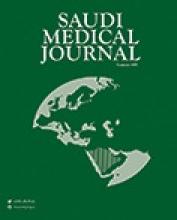Abstract
OBJECTIVE: To evaluate the prevalence of Helicobacter pylori (H. pylori) among Saudi medical students.
METHODS: Volunteer medical students were randomly selected in the College of Medicine, King Saud University, Riyadh, Saudi Arabia from January 2005 to May 2005. A urea breath test (UBT) was performed for each medical student. Important demographic data was recorded. Each student had to answer a questionnaire on upper gastrointestinal (UGI) symptoms before the UBT.
RESULTS: A total of 120 students were recruited (73 males [61%] and 47 females [39%]) with a mean age of 22.2 years (age varied from 18 to 28 years). The prevalence of H. pylori was surprisingly low at 35%, compared to a previously reported high prevalence among the Saudi population (80%). Thirty-one percent of medical students reported >/= 1 UGI symptom with no significant differences between the positive and negative UBT results. Although there was a trend, there was no significant prevalence difference between the preclinical and the clinical group of students.
CONCLUSION: We found a low prevalence of H. pylori in our young university medical student's population. The low prevalence of H. pylori in this young population may have important clinical and economic implications.
- Copyright: © Saudi Medical Journal
This is an open-access article distributed under the terms of the Creative Commons Attribution-Noncommercial-Share Alike 3.0 Unported, which permits unrestricted use, distribution, and reproduction in any medium, provided the original work is properly cited.






